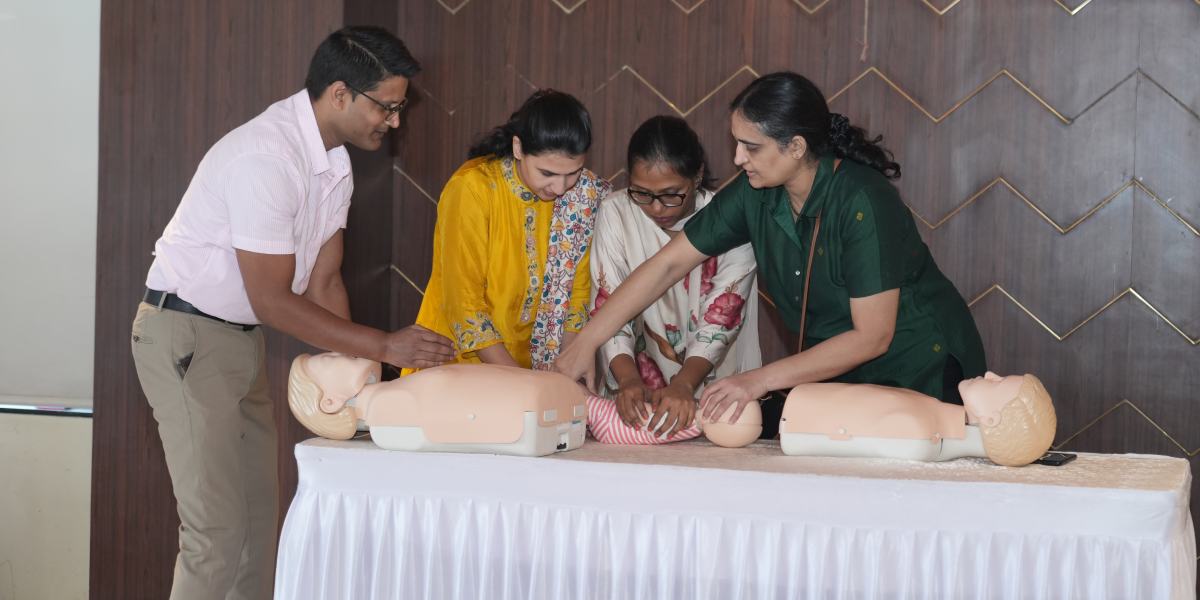The Kerala chapter of the Indian Medical Association (IMA) has launched a statewide initiative, "Every Citizen is a Lifesaver," to train people in emergency life-saving techniques like CPR and BLS through IMA’s 108 branches across Kerala
Published Feb 06, 2025 | 9:00 AM ⚊ Updated Feb 06, 2025 | 9:00 AM

CPR training
Synopsis: On average, about 25,000 people die of heart attack each year in Kerala; Cardiopulmonary Resuscitation (CPR) within minutes of a person collapsing can reduce fatalities significantly. The training of the general population would go a long way in making people better equipped to deal with such emergencies
If a child chokes on food or someone collapses due to cardiac arrest, having a person at hand who knows how to perform Cardiopulmonary Resuscitation (CPR) or Basic Life Support (BLS) would make all the difference between life and death.
Recognising the need to equip citizens with these crucial skills, the Kerala chapter of the Indian Medical Association (IMA) has launched a novel initiative to train people across all sections of society in emergency life-saving techniques.
“Every Citizen is a Lifesaver,” is the motto of the initiative, spearheaded by IMA-Kerala’s Emergency Life Support (ELS) Training Committee.
The statewide programme will be implemented through IMA’s 108 branches across Kerala.
It will impart CPR and BLS training to students and the general public.
This initiative lays special emphasis on training high school, higher secondary, and college students.
Dr. GS Vijayakrishnan, chairman of the ELS Training Committee, explained that students can act as powerful conduits for spreading awareness. The lessons they learn will be shared at home, creating a ripple effect.
“Our vision is to make Kerala a model state in community-based emergency response. We want to empower every citizen to act swiftly and confidently in emergencies, potentially saving countless lives,” Dr. Vijayakrishnan said.
In the initial phase, 250 individuals from various walks of life will receive training; in time, these early trainees will serve to train others.
The training sessions will use realistic mannequins that mimic human bodies.
The mannequins will be used to train students on hand placement, compression pressure, and the technique used during CPR.
This hands-on approach will help participants learn how to perform life-saving CPR.
“In case of an electric shock causing loss of consciousness, administering CPR can help revive the person. In cases of food aspiration — when food accidentally enters the airway instead of the digestive tract — knowing how to respond can save lives,” Dr. Vijayakrishnan said.
Bystander intervention in emergency is a much neglected area of healthcare, and prompt and effective intervention could help revive patients.
Dr. Harikrishnan S, senior professor and head of the Department of Cardiology at Sree Chitra Tirunal Institute for Medical Sciences and Technology, strongly advocates for including CPR and BLS training in Plus Two and college curricula across all disciplines.
“CPR saves lives. Studies show that only 10% of out-of-hospital cardiac arrest victims survive. However, immediate CPR can improve survival rates by another 10 percent,” he told South First.
Dr. Harikrishnan also highlighted the importance of bystander CPR — it serves as a crucial bridge until emergency medical services (EMS) arrive.
On World Heart Day in September 2024, Kerala Health Minister Veena George announced that the state’s health department was launching a project to train citizens in CPR, recognising its life-saving potential.
However, no follow up was done after that announcement.
Meanwhile, Vijayakrishnan said talks will be held with the health department to check whether the two programmes could be clubbed.
Studies published in Resuscitation Plus (2023) reveal that cardiac arrest is a major global public health concern.
The annual incidence of emergency medical services (EMS)-treated out-of-hospital cardiac arrest (OHCA) ranges from 30 to 97 per 100,000 people.
The brain begins to die within 3-5 minutes of circulatory arrest, and the overall survival rate is just 2-10 percent.
However, research shows that every minute without CPR reduces survival chances by 10 percent, while immediate CPR improves survival by 2-3 percent per minute.
Since 70 percent of cardiac arrests occur at home, training every citizen in CPR could dramatically increase survival rates.
IMA has been conducting CPR and BLS training for some time, but this new initiative aims to scale up the effort and reach more people.
The programme will also collaborate with farmer clubs and other community groups to maximize its impact.
To ensure the sustainability of the programme, IMA plans to introduce a “Training of Trainers” model, where those who complete the training will pass on their knowledge to others.
Healthcare providers emphasise that CPR is a critical link in the chain of survival.
Hands-Only CPR, which involves only chest compressions without mouth-to-mouth resuscitation, is recommended for use by the general public in cases of sudden collapse.
“Keeping blood flow active, even partially, extends the opportunity for successful resuscitation until trained medical personnel arrive,” experts say.
This initiative is expected to transform Kerala into a state where every citizen is equipped to act in an emergency, to reduce preventable deaths.
A society where life-saving skills are as common would be a safer one.
Kerala, with this programme, sets a gold standard in community-based emergency response, proving that “Two Hands Can Save a Life.”
(Edited by Rosamma Thomas)
